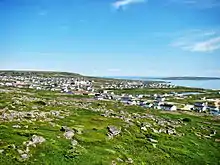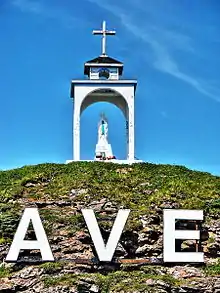Lourdes-de-Blanc-Sablon, Quebec
Lourdes-de-Blanc-Sablon is an unconstituted locality (as defined by Statistics Canada in the Canada 2011 Census) within the municipality of Blanc-Sablon in the Côte-Nord region of Quebec, Canada.
Lourdes-de-Blanc-Sablon | |
|---|---|
Unconstituted locality | |
 Lourdes-de-Blanc-Sablon | |
| Coordinates: 51°24′41″N 57°12′11″W[1] | |
| Country | |
| Province | |
| Region | Côte-Nord |
| RCM | Le Golfe-du-Saint-Laurent |
| Municipality | Blanc-Sablon |
| Government | |
| • Federal riding | Manicouagan |
| • Prov. riding | Duplessis |
| Area | |
| • Land | 9.63 km2 (3.72 sq mi) |
| Population (2011)[2] | |
| • Total | 828 |
| • Density | 86.0/km2 (223/sq mi) |
| • Change (2006–11) | |
| • Dwellings | 374 |
| Time zone | UTC-4 (AST) |
| Postal code(s) | G0G 1W0 |
| Area code(s) | 418 and 581 |

Jacques Cartier landed at the place in 1534 and set up a cross near the current site of Lourdes-de-Blanc-Sablon. The name was known before the Jacques Cartier's explorations. In his accounts of the 1534 voyage, he cites three times Blanc-Sablon, without any explanation. Sablon is an old French term meaning Fine Sand.[3] In 1858, the Mission of Longue-Pointe-de-Blanc-Sablon was established and took the name Lourdes-de-Blanc-Sablon or Notre-Dame-de-Lourdes at the end of 19th century.
Lourdes-de-Blanc-Sablon (51°24′41″N 57°12′11″W) is the largest of three communities forming the municipality of Blanc-Sablon (Blanc-Sablon, Lourdes-de-Blanc-Sablon, and Brador Bay), and is located on the headland that separates Brador Bay from Blanc-Sablon Bay. It was originally known as Longue-Pointe (Long Point) until the beginning of the 20th century. It has a small natural harbour, and long depended on the fishing business.[1] Its population in the 2011 census was 828.

Education
Commission scolaire du Littoral operates the Anglophone and Francophone school Mgr-Scheffer School in Lourdes-de-Blanc-Sablon.[4]
Climate
Lourdes-de-Blanc-Sablon has a subarctic climate (Köppen Dfc) that is influenced by the surrounding sea, moderating summer temperatures, and also ensuring winters are less severe than inland, although this region of Quebec is severely cold annually by global standards for the latitude.
| Climate data for Lourdes-de-Blanc-Sablon, Quebec | |||||||||||||
|---|---|---|---|---|---|---|---|---|---|---|---|---|---|
| Month | Jan | Feb | Mar | Apr | May | Jun | Jul | Aug | Sep | Oct | Nov | Dec | Year |
| Record high °C (°F) | 9.1 (48.4) |
8.3 (46.9) |
8.1 (46.6) |
18.6 (65.5) |
20.5 (68.9) |
26.0 (78.8) |
27.1 (80.8) |
28.1 (82.6) |
23.3 (73.9) |
16.2 (61.2) |
16.2 (61.2) |
7.8 (46.0) |
28.1 (82.6) |
| Average high °C (°F) | −7.7 (18.1) |
−7.4 (18.7) |
−3.0 (26.6) |
2.5 (36.5) |
7.9 (46.2) |
12.3 (54.1) |
15.7 (60.3) |
16.6 (61.9) |
12.9 (55.2) |
7.1 (44.8) |
2.1 (35.8) |
−3.8 (25.2) |
4.6 (40.3) |
| Daily mean °C (°F) | −12.7 (9.1) |
−12 (10) |
−7.3 (18.9) |
−1.0 (30.2) |
3.8 (38.8) |
8.3 (46.9) |
12.0 (53.6) |
12.8 (55.0) |
9.0 (48.2) |
3.6 (38.5) |
−1.5 (29.3) |
−8.1 (17.4) |
0.6 (33.1) |
| Average low °C (°F) | −17.5 (0.5) |
−16.5 (2.3) |
−11.4 (11.5) |
−4.4 (24.1) |
−0.3 (31.5) |
4.2 (39.6) |
8.1 (46.6) |
9.0 (48.2) |
5.0 (41.0) |
0.2 (32.4) |
−5.1 (22.8) |
−12.4 (9.7) |
−3.4 (25.9) |
| Record low °C (°F) | −32.3 (−26.1) |
−34.1 (−29.4) |
−32.5 (−26.5) |
−23.0 (−9.4) |
−11.1 (12.0) |
−3.6 (25.5) |
0.0 (32.0) |
1.8 (35.2) |
−4.8 (23.4) |
−10.4 (13.3) |
−18.9 (−2.0) |
−30.2 (−22.4) |
−34.1 (−29.4) |
| Average precipitation mm (inches) | 97.2 (3.83) |
83.8 (3.30) |
80.1 (3.15) |
49.9 (1.96) |
69.4 (2.73) |
92.0 (3.62) |
102.0 (4.02) |
96.3 (3.79) |
88.8 (3.50) |
87.8 (3.46) |
74.9 (2.95) |
99.6 (3.92) |
1,021.7 (40.22) |
| Average rainfall mm (inches) | 11.8 (0.46) |
7.9 (0.31) |
11.5 (0.45) |
20.5 (0.81) |
62.0 (2.44) |
91.4 (3.60) |
101.9 (4.01) |
96.5 (3.80) |
88.8 (3.50) |
81.9 (3.22) |
48.0 (1.89) |
24.1 (0.95) |
646.0 (25.43) |
| Average snowfall cm (inches) | 85.4 (33.6) |
75.7 (29.8) |
68.6 (27.0) |
29.1 (11.5) |
7.4 (2.9) |
0.7 (0.3) |
0.0 (0.0) |
0.0 (0.0) |
0.0 (0.0) |
6.0 (2.4) |
26.9 (10.6) |
75.5 (29.7) |
375.3 (147.8) |
| Source: Environment Canada[5] | |||||||||||||
References
- Reference number 37215 of the Commission de toponymie du Québec (in French)
- "(Code 240224) Census Profile". 2011 census. Statistics Canada. 2012.
- "Blanc-Sablon (Municipalité)" (in French). Commission de toponymie du Québec. Retrieved 2010-09-30.
- "Schools and centers." Commission scolaire du Littoral. Retrieved on September 23, 2017.
- "Lourdes-de-Blanc-Sablon". Canadian Climate Normals 1981–2010 (in English and French). Environment Canada. Retrieved June 6, 2015.